陈家祠PPT课件
- 格式:ppt
- 大小:5.70 MB
- 文档页数:4
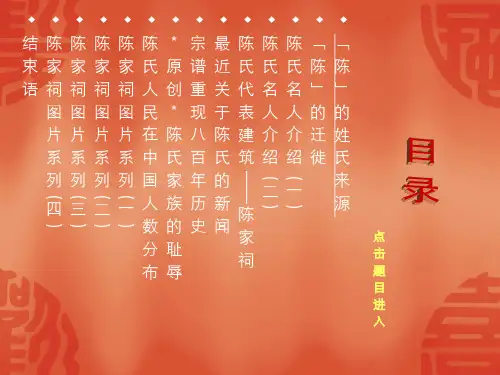
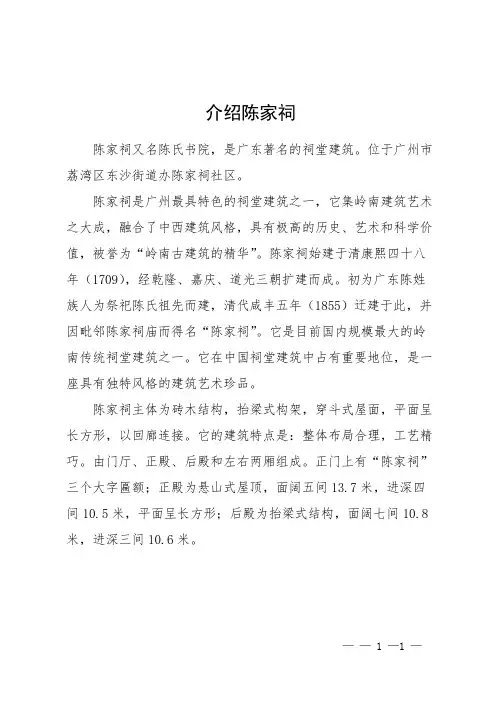
介绍陈家祠
陈家祠又名陈氏书院,是广东著名的祠堂建筑。
位于广州市荔湾区东沙街道办陈家祠社区。
陈家祠是广州最具特色的祠堂建筑之一,它集岭南建筑艺术之大成,融合了中西建筑风格,具有极高的历史、艺术和科学价值,被誉为“岭南古建筑的精华”。
陈家祠始建于清康熙四十八年(1709),经乾隆、嘉庆、道光三朝扩建而成。
初为广东陈姓族人为祭祀陈氏祖先而建,清代咸丰五年(1855)迁建于此,并因毗邻陈家祠庙而得名“陈家祠”。
它是目前国内规模最大的岭南传统祠堂建筑之一。
它在中国祠堂建筑中占有重要地位,是一座具有独特风格的建筑艺术珍品。
陈家祠主体为砖木结构,抬梁式构架,穿斗式屋面,平面呈长方形,以回廊连接。
它的建筑特点是:整体布局合理,工艺精巧。
由门厅、正殿、后殿和左右两厢组成。
正门上有“陈家祠”三个大字匾额;正殿为悬山式屋顶,面阔五间13.7米,进深四间10.5米,平面呈长方形;后殿为抬梁式结构,面阔七间10.8米,进深三间10.6米。
—— 1 —1 —。
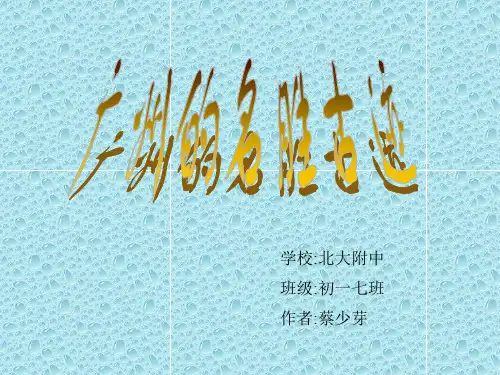
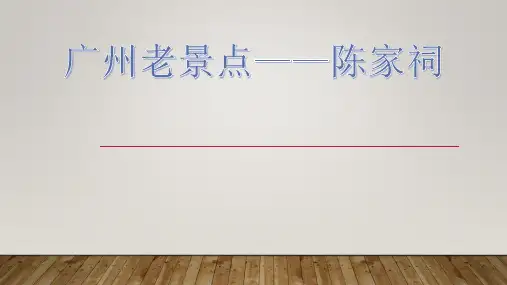

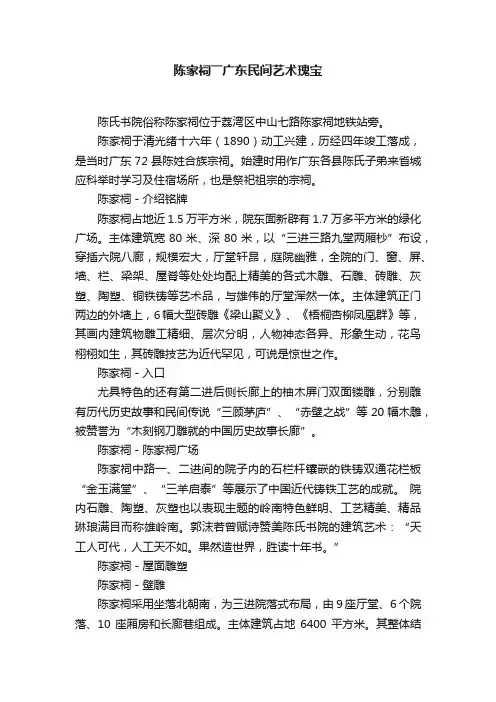
陈家祠――广东民间艺术瑰宝陈氏书院俗称陈家祠位于荔湾区中山七路陈家祠地铁站旁。
陈家祠于清光绪十六年(1890)动工兴建,历经四年竣工落成,是当时广东72县陈姓合族宗祠。
始建时用作广东各县陈氏子弟来省城应科举时学习及住宿场所,也是祭祀祖宗的宗祠。
陈家祠-介绍铭牌陈家祠占地近1.5万平方米,院东面新辟有1.7万多平方米的绿化广场。
主体建筑宽80米、深80米,以“三进三路九堂两厢杪”布设,穿插六院八廊,规模宏大,厅堂轩昂,庭院幽雅,全院的门、窗、屏、墙、栏、梁架、屋脊等处处均配上精美的各式木雕、石雕、砖雕、灰塑、陶塑、铜铁铸等艺术品,与雄伟的厅堂浑然一体。
主体建筑正门两边的外墙上,6幅大型砖雕《梁山聚义》、《梧桐杏柳凤凰群》等,其画内建筑物雕工精细、层次分明,人物神态各异、形象生动,花鸟栩栩如生,其砖雕技艺为近代罕见,可说是惊世之作。
陈家祠-入口尤具特色的还有第二进后侧长廊上的柚木屏门双面镂雕,分别雕有历代历史故事和民间传说“三顾茅庐”、“赤壁之战”等20幅木雕,被赞誉为“木刻钢刀雕就的中国历史故事长廊”。
陈家祠-陈家祠广场陈家祠中路一、二进间的院子内的石栏杆镶嵌的铁铸双通花栏板“金玉满堂”、“三羊启泰”等展示了中国近代铸铁工艺的成就。
院内石雕、陶塑、灰塑也以表现主题的岭南特色鲜明、工艺精美、精品琳琅满目而称雄岭南。
郭沫若曾赋诗赞美陈氏书院的建筑艺术:“天工人可代,人工天不如。
果然造世界,胜读十年书。
”陈家祠-屋面雕塑陈家祠-壁雕陈家祠采用坐落北朝南,为三进院落式布局,由9座厅堂、6个院落、10座厢房和长廊巷组成。
主体建筑占地6400平方米。
其整体结构布局严谨、虚实相间,厅堂轩昂,庭院宽敞幽雅,特别是在建筑装饰上集中体现了广东民间建筑装饰艺术之精华。
其内外建筑构件上巧妙地采用了木雕、石雕、砖雕、陶塑、灰塑、铜铁铸等工艺装饰。
图案题材广泛,造型生动逼真,雕刻技艺精湛,用笔简炼粗放却又精雕细琢。
可以说,陈氏书院不愧为一座宏伟瑰丽的民间工艺建筑宝库。
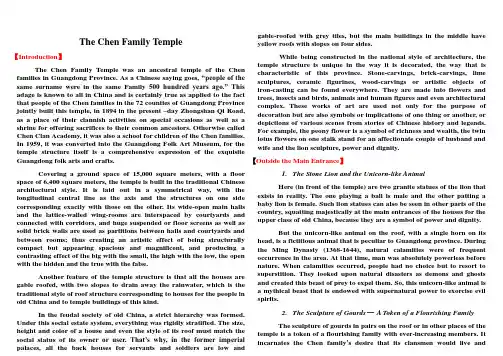
The Chen Family Temple【Introduction】The Chen Family Temple was an ancestral temple of the Chen families in Guangdong Province. As a Chinese saying goes, “people of the same surname were in the same Family 500 hundred years ago.” This adage is known to all in China and is certainly true as applied to the fact that people of the Chen families in the 72 counties of Guangdong Province jointly built this temple, in 1894 in the present –day Zhongshan Qi Road, as a place of their clannish activities on special occasions as well as a shrine for offering sacrifices to their common ancestors. Otherwise called Chen Clan Academy, it was also a school for children of the Chen families. In 1959, it was converted into the Guangdong Folk Art Museum, for the temple structure itself is a comprehensive expression of the exquisite Guangdong folk arts and crafts.Covering a ground space of 15,000 square meters, with a floor space of 6,400 square meters, the temple is built in the traditional Chinese architectural style. It is laid out in a symmetrical way, with the longitudinal central line as the axis and the structures on one side corresponding exactly with those on the other. Its wide-open main halls and the lattice-walled wing-rooms are interspaced by courtyards and connected with corridors, and huge suspended or floor screens as well as solid brick walls are used as partitions between halls and courtyards and between rooms; thus creating an artistic effect of being structurally compact but appearing spacious and magnificent, and producing a contrasting effect of the big with the small, the high with the low, the open with the hidden and the true with the false.Another feature of the temple structure is that all the houses are gable roofed, with two slopes to drain away the rainwater, which is the traditional style of roof structure corresponding to houses for the people in old China and to temple buildings of this kind.In the feudal society of old China, a strict hierarchy was formed.Under this social estate system, everything was rigidly stratified. The size, height and color of a house and even the style of its roof must match the social status of its own er or user. That‟s why, in the former imperial palaces, all the back houses for servants and soldiers are low and gable-roofed with grey tiles, but the main buildings in the middle have yellow roofs with slopes on four sides.While being constructed in the national style of architecture, the temple structure is unique in the way it is decorated, the way that is characteristic of this province. Stone-carvings, brick-carvings, lime sculptures, ceramic figurines, wood-carvings or artistic objects of iron-casting can be found everywhere. They are made into flowers and trees, insects and birds, animals and human figures and even architectural complex. These works of art are used not only for the purpose of decoration but are also symbols or implications of one thing or another, or depictions of various scenes from stories of Chinese history and legends. For example, the peony flower is a symbol of richness and wealth, the twin lotus flowers on one stalk stand for an affectionate couple of husband and wife and the lion sculpture, power and dignity.【Outside the Main Entrance】1.The Stone Lion and the Unicorn-like AnimalHere (in front of the temple) are two granite statues of the lion that exists in reality. The one playing a ball is male and the other patting a baby lion is female. Such lion statues can also be seen in other parts of the country, squatting majestically at the main entrances of the houses for the upper class of old China, because they are a symbol of power and dignity.But the unicorn-like animal on the roof, with a single horn on its head, is a fictitious animal that is peculiar to Guangdong province. During the Ming Dynasty (1368-1644), natural calamities were of frequent occurrence in the area. At that time, man was absolutely powerless before nature. When calamities occurred, people had no choice but to resort to superstition. They looked upon natural disasters as demons and ghosts and created this beast of prey to expel them. So, this unicorn-like animal isa mythical beast that is endowed with supernatural power to exorcise evil spirits.2.The Sculpture of Gourds—A Token of a Flourishing FamilyThe sculpture of gourds in pairs on the roof or in other places of the temple is a token of a flourishing family with ever-increasing members. It incarnates the Chen family‟s desire that its clansmen would live and multiply continuously like gourds growing luxuriantly to propagate successively. This is because the gourd is a seedy plant and its many seeds will propagate in great numbers.3.Masterpieces of Brick-carvingOn the wall on either side of the main entrance is a picture carved on bricks, depicting different stories from Chinese historical novels. They are regarded as representative works of the exquisite Guangdong brick-carving.The Guangdong brick-carving is unique in the technique of its making. It is made in such a way that different parts of a picture are carved separately on small pieces of ready-made fired bricks before they are laid onto a wall to form an integral whole, whereas those of other provinces are made by carving a whole picture on a big piece of adobe (unburned brick) before it is fired into a hard cube and embedded onto the wall. The former entails much more precision and skill and so is more exquisite and is of greater artistic value.(1)Liu Qing Taming a Fierce HorseThe brick-carving on the east side (on our right hand side when facing the temple) depicts the story of Liu Qing, a valiant general of the Northern Song Dynasty (960-1127), who succeeded in taming a fierce horse that was sent by an aggressive neighboring state. The aggressor state had sent the horse as a challenge, threatening that, if nobody in Song‟s domain could get the horse under control, they would sent troops to attack. Liu Qing‟s courage and valor greatly crushed the enemy‟s arrogance and thus avoided a war.(2)The Heros Gathering in Revolt in LiangshanThe brick-carving on the west side (on our left hand when facing the temple) illustrates the happy occasion for the peasant uprising leaders getting togeter to celebrate their unity in their unity in their revolt against the corrupt regime of the Northern Song Dynasty. The story is written in a famous Chinese classical nove, The Water Margin, which is very popular among the Chinese.4.The Stone DrumsThe stone drums at the main entrance are a symbol of social status of the Chen family. In the feudal society of the Qing Dynasty, people could place a pair of drums in front of their house only when someone in their family had been conferred an academic degree of (or higher than) “jinshi”, a title given to successful candidates in the imperial examination. In 1893, the year before the temple was completed, a member of the Chen family, Chen Botao by name, was awarded by the Qing court a title of “tanhua”, the number three scholar in the highest imperial examination, and so these drums were mounted here in his honor.5.The Kylin and Its Treasured BooksThe relief sculpture on the wall behind the stone drum on our left (when facing the temple) is called The Kylin and Its Treasured Books. The kylin is a Chinese mythical animal, with an appearance of a deer, a tail of an ox and a body covered all over with scales like a fish.Tradition says that the kylin is an omen of auspice and was brought into being on the same day as Confucius was born. In the Chinese classics, the kylin is often likened to a great man of noble moral character; therefore the kylin here is, in fact, the incarnation of Confucius, who has been reputed as the greatest philosopher and teacher of morals for over 2000 years in China.This sculpture was made to encourage people to strive for scholarlyhonors and official positions by way of studying the works of Confucius.6.To Be Conferred a Title of NobilityThe relief sculpture behind the stone drum on our right hand side (when facing the temple) is also an implicative picture. The bird, the deer, the bee and the monkey combine to imply that people of the Chen family would be conferred scholarly honors and appointed high official positions with handsome salaries by the imperial court, because the Chinese characters for bird, deer, bee and monkey are homonymous respectively with those for “title of nobility”, “official salary”and “granting titles to the nobles”.7.The Door GodsThe two portraits on the door-leaves are door-gods. Original door-gods were two legendary gods, Shentu and Yulei, who, it is said, were able to catch ghosts and protect a house from evil spirits. Attired in fancy armors, with a rope in their hands, they looked awe-inspiring. Since the Tang Dynasty (618-907), door-gods have gradually been replaced by people in real life, which is a tradition started by Emperor Taizong of the Tang Dynasty. It is said that, one day, the emperor was frightened by ghostly wailing from outside his bedroom and he could not fall asleep. Two of his faithful generals, Qin Qiong and Yuchi Gong, offered to guard his bedroom at night, so the emperor slept soundly. His Majesty then ordered that the portraits of the two generals be put up on his bedroom door and this also kept the ghosts away. Since then the two generals have been regarded as door-gods.【In the Front Hall】The Teak-Wood ScreenAmong all the works of art in the temple, the wood-carving is the most outstanding. This teak-wood screen, together with the one in the central hall, is indeed a rare piece of wood-carving in the local province and in the whole country as well. The most prominent feature of the wood-carving in the temple is that most of them are carved to penetrating through the wood from one side to the other, so the two sides are carefully made with exactly the same things but those on reserve side are placed just the other way round, as is the inverted image in the mirror.(1)To Create a Great Property to Benefit the Flourishing ofPosterityLook at this picture. A hen and some chicks are walking leisurely looking for food under the shade of the big leaves of a banana tree. The chickens here are not portrayed just for chicken‟s sake but are likened to the present generations of the family. Also, the big leaves of the banana tree are compared to the great property or great wealth created by past generations, because the Chinese words for “big leaf” and the words for “great property” ort “great wealth” are homophones of each other.The moral of the picture is that the great property created by the older generations is benefiting the younger generations; therefore, people of the present generations must also work hard to create more wealth for the benefit of the future generations.(2)A Man of Great Learning Is to Be Appointed Official PositionsThis picture is composed of many things and each has its own meaning:a. This is the emblem of Daoism called “Bagua”. Its eight diagrams stand for eight existences or phenomenon in nature (sky, earth, thunder, wind, water, fire, mountain and lake) and embody a profound theory. Here, they symbolize people‟s knowledge of all branches.b. The wine-pot: In the Chinese classics, a wine-pot with much or little wine in it is sometimes likened to a person of great or poor learning.c. The wine-cup: This is an ancient wine vessel and is likened to “title of nobility”, because the two things are meant by the same word in ancient Chinese.d. The ancient coin: Its meaning is self-evident, i.e., money and wealth.e. The phoenix: A mythical chicken-like bird that is regarded as a mascot whose presence is supposed to bring good luck.f. The kylin: A fictitious animal that is sometimes compared to a person of profound knowledge.So, “A man of great learning is sure to be conferred a little of nobility and appointed an official position with a handsome salary” is the main idea the picture implies.(3)A Man Filled with Elation and the Five BlessingsThis is a picture of an incense-burner with a wisp of smoke curling upward to form a Chinese character meaning “longevity”, which is surrounded by five bats. In the Chinese language, a person who is elated by his success is often described as one who proudly “blows off his breath”and “upwardly stretches his brows”. Therefore, the smoke emitted from the incense-burner is likened to the breath blown out from a person who is proud of his success.The five bats flying around the Chinese character for longevity stand for “five blessings” or “five good fortunes”, because the Chinese word for “bat”and the word for “blessing”are homophones of each other. According to the Chinese classics, the five blessings are “to live long, to be wealthy, to be healthy, to have cultivated morality and to die a natural death”. Therefore, the picture is an implicit illustration of people‟s aspiration for a successful and happy life.By the way, the idea of the “five blessings”is also illustrated in a picture of a peach fruit surrounded by five bats because, according to the Daoist mythology, the peach fruit borne from the peach tree planted by Tai Shang Lao Jun, one of the three supreme deities in Daoism, is said to be an elixir of life.(4)Young Folks Grow Up Fast but a Great Mind Matures LateThis is a bamboo stem that‟s grown into the shape of a Chinese character meaning “happiness” or “good fortune”. The bamboo shoots up very fast at the earlier stage of its growth, but it takes years for it to become mature enough for practical use. The picture suggests that a young man is quick to learn but a man of great learning needs years to shape or illustrates the meaning of an English proverb “Rome was not built in a day”. This is to encourage people to study with perennial efforts.In addition, a character for happiness that is composed of a bamboo stem also implies a greeting of “wishing somebody happiness”, because the Chinese word for “bamboo” is homonymous with the word for “wish”. So, “bamboo happiness” implies “wishing somebody happiness”.(5) The Advent of Good FortuneThis is an inverted Chinese character for “happiness”or “good fortune”-It is on the reverse side of the wood-carving and so is placed the other way round. The Chinese word for “inversion”and the word for “advent”are homophones of each other, so an inverted character for “good fortune”implies “the advent of good fortune”or “the coming of happiness”.【The Sage Meeting Hall】This is the central hall of the temple. It is called Sage Meeting Hall and was the place where the elders of the Chen family got together to discussed their clannish affair.On the ridge of the hall and on the balustrade around the platform in front of the hall, there are many works of art: lime-sculptures, pottery-sculptures, stone-carvings and artistic articles of metal-casting. They are all implications of one thing or another. For example:1.Sacrificial Offerings to AncestorsAt the top of the balusters are carved several kinds of fruit that abound in South China: peach, star-fruit, papaya and so on. They are symbolic offerings to the Chen family‟s ancestors.2.The Three “yangs” Usher in ProsperityEmbedded in the balustrade around the platform are metal-castings of different designs. Among them the one of three goats with the sun overhead is called “The Three‘yangs‟ Usher in Prosperity”.The Chinese word for goat is pronounced as “yang”, the same as the word for the sun, so the goat is an implication of the sun. In the Chinese classical philosophy, the “yang” (the sun) is the antithesis of the “yin”(the moon). The “yin” and the “yang” (the sun) are the negative and positive antitheses in the Chinese philosophic conception, whose growing and declining account for the rising and falling of the relative strength of the two principles in nature.The primary meanings of the “yin” and the “yang” refer to the two sides that are shaded from or exposed to the sun: the sunny side is the “yang”and the shady side is the “yin”. Therefore, the changing of the relative strength of the “yin” and the “yang” is often extended to mean the transit of seasons, from cold to warm or from warm to cold. When November comes, the “yin” begins to fall and the first “yang” rises. The second “yang” grows up in December and, when the third “yang” appears in January, spring comes round to the earth and everything takes on a new look ---a scene that heralds a period of properity.In the old days, this motto, “The Three …yangs‟Usher in Prosperity”, was a complimentary remark for the New Year‟s Day.ing out First in the Highest Imperial ExaminationThe two creatures sticking up from the ridge are heads of legendary turtles. During China‟s Tang and Song dynasties, a huge portrait of such a turtles-head was carved in front of the steps that led up to the emperor‟s throne in the imperial palace. When members of the imperial academy were presented at court they usually stood in the middle of the turtle-head and so “to be enrolled in the imperial academy”was often referred to as “going up to the turtle-head and “coming out first in the imperial examination” was known as “monopolizing the turtle-head”.Therefore, the turtle-heads mounted (1.7 meter-high) on the ridge indicate the Chen family‟s desire that its members would be honored with imperial scholarship and appointed official positions.【The Rear Hall and the Wing Rooms】Here is the rear hall of the temple and was the place where the Chen people worshiped their ancestors. On the shrine there used to be tablets of their ancestors, which were arranged in the order of seniority in the family. The one at the top was “Emperor Shun”, who was believed to be the remote ancestor of the Chen family. (Shun was the head of a tribal alliance dating back to the 21st century BC, when China‟s social structure was in the period of transition from clan commune to feudalism.) In the old days in every spring and autumn, grand sacrificial ceremonies were held here by the Chen clansmen to worship their common ancestors. This wooden shrine was made in 1890 during the reign of Emperor Guangxu of the Qing Dynasty and is the largest and the most exquisitely made ancestral shrine still in existence in Guangdong Province.The wing-rooms on the east and the west sides were classrooms where the Chen family children studied.。
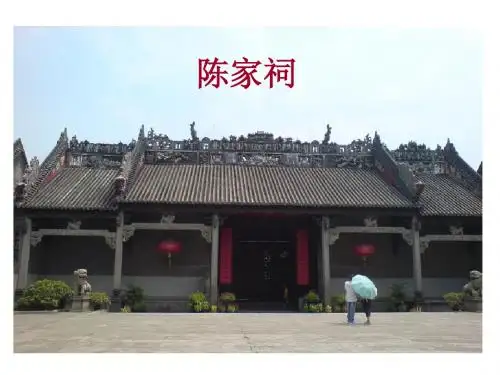
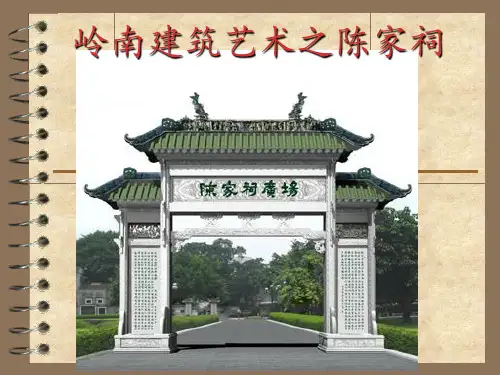
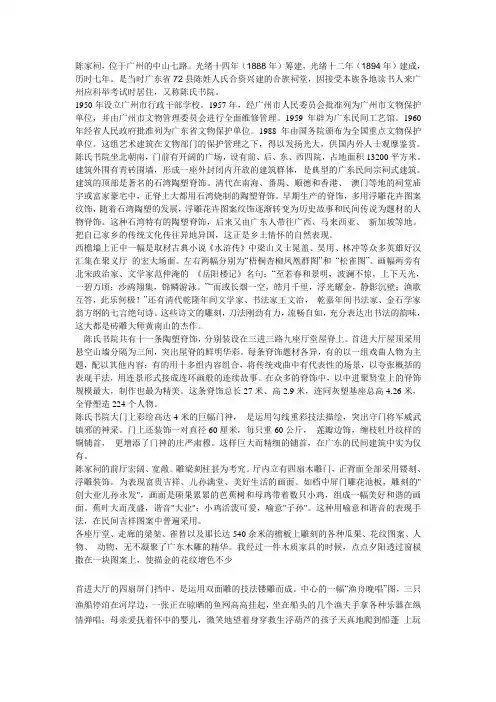
陈家祠,位于广州的中山七路。
光绪十四年(1888年)筹建,光绪十二年(1894年)建成,历时七年。
是当时广东省72县陈姓人氏合资兴建的合族祠堂,因接受本族各地读书人来广州应科举考试时居住,又称陈氏书院。
1950年设立广州市行政干部学校。
1957年,经广州市人民委员会批准列为广州市文物保护单位,并由广州市文物管理委员会进行全面维修管理。
1959年辟为广东民间工艺馆。
1960年经省人民政府批准列为广东省文物保护单位。
1988年由国务院颁布为全国重点文物保护单位。
这组艺术建筑在文物部门的保护管理之下,得以发扬光大,供国内外人士观摩鉴赏。
陈氏书院坐北朝南,门前有开阔的广场,设有前、后、东、西四院,占地面积13200平方米。
建筑外围有青砖围墙,形成一座外封闭内开放的建筑群体,是典型的广东民间宗祠式建筑。
建筑的顶部是著名的石湾陶塑脊饰。
清代在南海、番禺、顺德和香港、澳门等地的祠堂庙宇或富家豪宅中,正脊上大都用石湾烧制的陶塑脊饰。
早期生产的脊饰,多用浮雕花卉图案纹饰,随着石湾陶塑的发展,浮雕花卉图案纹饰逐渐转变为历史故事和民间传说为题材的人物脊饰。
这种石湾特有的陶塑脊饰,后来又由广东人带往广西、马来西亚、新加坡等地。
把自已家乡的传统文化传往异地异国,这正是乡土情怀的自然表现。
西檐墙上正中一幅是取材古典小说《水浒传》中梁山义士晁盖、昊用、林冲等众多英雄好汉汇集在聚义厅的宏大场面。
左右两幅分别为“梧桐杏柳凤凰群图”和“松雀图”。
画幅两旁有北宋政治家、文学家范仲淹的《岳阳楼记》名句:“至若春和景明,波澜不惊,上下天光,一碧万顷;沙鸥翔集,锦鳞游泳。
”“而或长烟一空,皓月千里,浮光耀金,静影沉壁;渔歌互答,此乐何极!”还有清代乾隆年间文学家、书法家王文治,乾嘉年间书法家、金石学家翁方纲的七言绝句诗。
这些诗文的雕刻,刀法刚劲有力,流畅自如,充分表达出书法的韵味,这大都是砖雕大师黄南山的杰作。
陈氏书院共有十一条陶塑脊饰,分别装设在三进三路九座厅堂屋脊上。

民间先祖宗祠——陈家祠堂陈家祠堂又称“陈氏书院”,俗称陈家祠,位于广州市中山七路。
陈氏书院筹建于清光绪十四年(1888),二十年(1894)落成,是广东省各地陈氏宗族共同捐资兴建的“合族祠”,为陈氏宗族子弟赴省城备考科举、候任、交纳赋税、诉讼等事务提供临时居所。
陈家祠堂是现存规模最大的广府传统建筑之一,也是我国现存规模最大、保存最完好、装饰最精美的祠堂式建筑,被誉为“岭南建筑艺术的明珠”。
占地面积15000平方米,建筑面积达8000平方米,建筑结构可分为三轴、三进,共有九座厅堂和六个院落。
陈家祠堂集岭南建筑工艺装饰之大成,几乎全部堂、院、廊、厅、门、窗、栏、壁、屋脊、架梁都展示了岭南建筑的“三雕二塑一铸一画”即木雕、砖雕、石雕、陶塑、灰塑、铜铁铸及彩绘壁画等建筑装饰的高超技艺。
二十世纪二三十年代,被收录进德国的《世界建筑艺术》和英国的《中国古代艺术建筑》两本巨著中。
陈家祠也是广东民间工艺博物馆所在地,为国家一级博物馆,馆藏各类珍贵文物与现代工艺精品共计20000多件,其中国家级珍贵文物近3000件,是广东省内博物馆中收藏明清以来广东民间工艺精品最为丰富的艺术类博物馆,包括石湾陶、广彩瓷、象牙雕刻、粤绣、广州木雕、砖雕、石雕等多种技艺的载体,涵盖了广东省所有已列入国家级非物质文化遗产名录的工艺门类。
陈家祠是广州市著名的文化旅游景点,1988年被列为全国重点文物保护单位,2002年被评为“新世纪羊城八景”之一。
陈氏书院由曾任翰林院等职的东莞陈伯陶等48位陈姓绅士倡议兴建,以“汉代太邱太祖”为始祖,是清末广东省七十二县的陈姓宗亲合资在广州兴建的合族祠,其主要用途是为全省各地陈姓族人在广州备考科举、办理诉讼、缴纳赋税等事宜提供居住的场所。
1888年(光绪十四年),以陈颖川堂和陈世昌堂的名义购买广州西门口外的连元街、荔枝湾福水塘、恩龙里等总面积约36600平方米的房产兴建陈氏书院。
至1894年(光绪二十年),书院落成。
陈家祠THE CHENS’ ANCESTRAL HALLGood morning, ladies and gentlemen! Welcome to the Chens’ Ancestral Hall!Chen is a popular surname shared by a great many of people in China, especially in South China. This building was set up by most of the Chen people in Guangdong province in 1894 for worship of their ancestors. The children of the Chen families used to study here temporarily when they came to the provincial capital for imperial examination, so it’s also called the Chen’s academy.The stone drums in front of the main gate were the symbol of social status of the family. Only when someone in the family took a high position in the imperial court, could they set big stone drums outside the ancestral hall. The bigger the drums, the higher the status is.To paste the pictures of some special figures on the door is an old custom in China. People believe these pictures can protect the house from evils, and call them gods of the door. Usually the pictures should be replaced every year, so that they can keep new and colourful. The wood screen door is to stop people from seeing through the building directly. They may be opened on the days for worship only to welcome the guests. Its upper part was done in openwork to let through light and air. The relief sculptures on the lower part tell people what the Chen family thinking about at that time.The most colourful and splendid decoration is the decoration on the roof ridge. There are two different kinds of crafts there. The upper part is made of pottery sculptures. That means they’ve been fired and the colour won’t go down easily. The next part is made of lime sculptures. This part was done on the spot and never fired. They need repainting every four or five years. This style of ridge decoration is very typical in South China.This ancestral hall is the largest one existing in Guangdong province. It covers a total area of 15,000 square metres, consists of altogether nine halls, which are divided into three rows. In 1959, Guangzhou municipal government established a museum here for Guangdong folk arts. So now there are various exhibitions of folk arts in each hall.This is a clay sculpture exhibition by a local artist, Mr. Wan Zhaoquan. It shows how the Guangzhou people live at the end of last century.Ceramic industry has a long history both in China and in Guangdong Province. This exhibition displays the fine works of ceramic collected by the museum. This hall is the centre of the whole building. Its Chinese name Juxiantang means the hall where able and virtuous people gather. The elder and wise members of the Chen family used to meet here to discuss important affairs.This is the middle hall of the third row. It’s designed to place the memorial tablets of the Chen ancestors. Once there were altogether more than 12,000 memorial tablets worshiped here. Unfortunately, they were destroyed during the cultural revolutionary. And now, no original tablets and no worship here. It’s now an exhibition room for carvings.This exhibition is about one of the most traditional art in China, em broidery. It’s a kind of art to create beautiful pictures on a piece of cloth with needle and thread. Generally speaking,there are four famous styles of embroideries in China, respectively from Jiangsu province, Hunan province, Sichuan province and Guangdong province. Guangdong style of embroidery is featured by the strongly contrasting colour and the full composition of the whole picture.This is the wing-room which used to be the classroom for the children. Most of the furniture in this exhibition is made of red wood. They show the normal style of furniture in Guangzhou families in the Qing dynasty.Guangdong area. The temple is a Makka for believers and a must for tourists.。
3、陈家祠讲解线索:【简介】——【建筑特点】——【一进(大门外)】——【二进(首进大厅和聚贤堂)】——【后进】——【西斋和厢房】【简介】陈家祠位于广州市中山七路,又叫做陈氏书院。
它在光绪16年开始动工,经过4年时间,在光绪20年建成,是当时广东72县陈姓族人捐资合建的宗族祠和书院。
清朝末年废除科举制度之后,改办称为了学校。
新中国成立之后,人民政府十分重视这座建筑,成立了专门的保护机制,对它进行多次的修葺,在1959年建成了广东民间艺术博物馆,在1988年被国务院评为全国重点文物保护单位。
陈家祠的主题建筑坐北向南,占地面积达到1.5万平方米,主体建筑面积为6400平方米。
平面呈正方形,长宽各约80米,“深三进,广五间”,包括9座厅堂,东西斋10座房子和其间的6座庭院,大小合计19座,聚贤堂位于正中央,其他按中轴线依次排列,相互间以长廊联通,组成外封闭、内开放的形式。
门前坪地和东西后三院环绕四周,与内部庭院相应。
从外往里看,长廊贯穿南北,庭院层层想通,一进高于一进,最高处达到16.8迷。
这种布局严谨、主次分明、虚实结合、前低后高的形式体现了我国南方祠堂建筑的规矩和传统的艺术风格。
因此,陈家祠被誉为:岭南艺术建筑明珠。
【建筑特点】陈家祠的建筑特点有两个,第一,每座房子从柱基到瓦脊全部都缀满了石雕、砖雕、木雕、泥塑、陶塑、铁铸和彩绘等,琳琅满目。
他们的题材都是著名的历史故事和地方风物,精雕细刻,用材讲究,确确实实是一座宏伟瑰丽的民间艺术宝库。
第二,极具岭南风味。
那些华丽的装饰、陡峭的瓦脊、小巧的拱门和各种比例、手法都突出表现了岭南的建筑风格。
长廊贯通全院遮阳挡雨,放射高大阴凉,内外庭院满目苍翠,与广州亚热带气候十分适应,让人觉得优雅宜人,极具岭南风味。